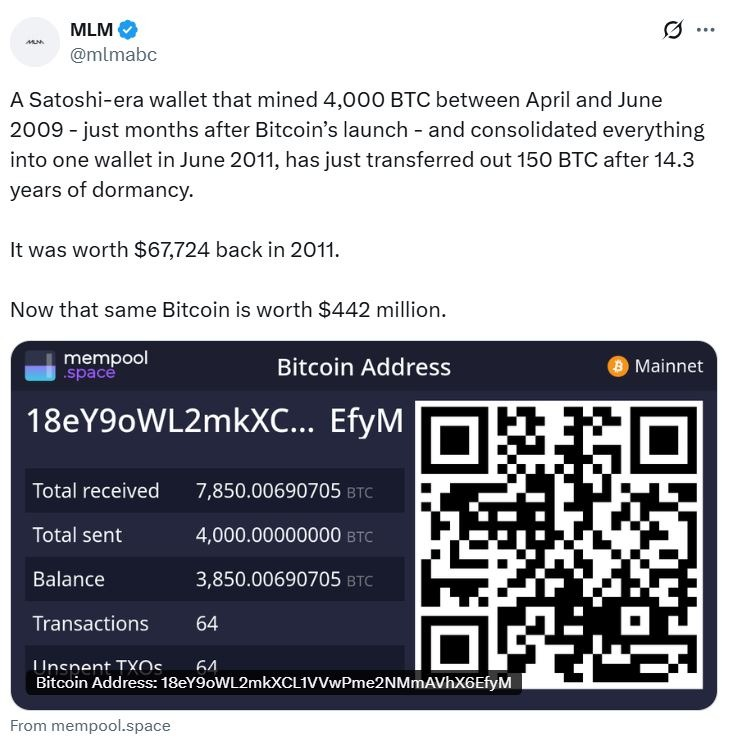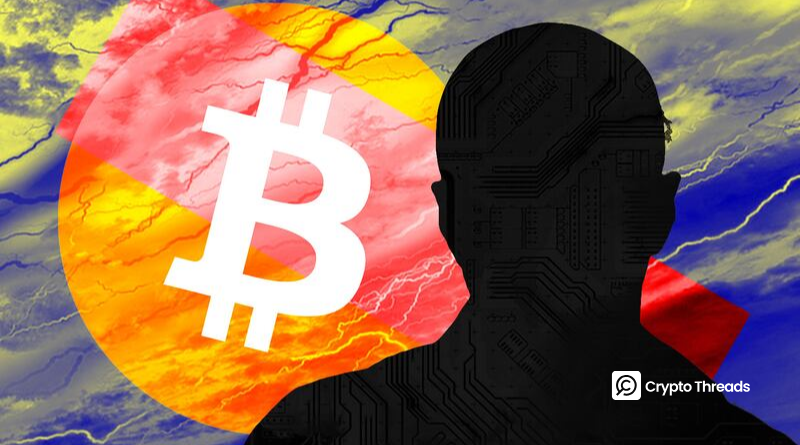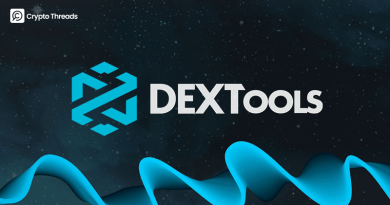2009 Satoshi-Era Bitcoin Wallet Awakens After 14 Years, Moves $442 Million in BTC
- A Satoshi-era Bitcoin wallet from 2009 has become active after 14 years of silence.
- The wallet mined 4,000 BTC soon after Bitcoin’s launch.
- It recently transferred 150 BTC worth over $16 million.
- The address may have once held up to 8,000 BTC in total.
- Analysts say these whale movements show a maturing Bitcoin market, not panic selling.
A Satoshi-era Bitcoin wallet – one that dates back to the very beginning of Bitcoin’s history — has suddenly come alive. After staying inactive for over 14 years, the wallet moved 150 Bitcoin, worth around $16 million, on Thursday, according to on-chain tracker Whale Alert.
This wallet is believed to belong to an early miner who started collecting Bitcoin between April and June 2009, only a few months after the Bitcoin network first launched. During that period, mining was simple and done mostly by a small group of early adopters, possibly including Satoshi Nakamoto and his peers.
At today’s price of around $110,600 per BTC, this whale’s entire stash is now worth over $442 million – a massive increase from its original value of just a few hundred dollars when mined.
From 2009 Mining to 2025 Transfers
According to Nansen and Mempool Space, the Bitcoin address has had several large transactions over the years. It once consolidated 4,000 BTC into one wallet in June 2011, and may have originally held around 7,850 to 8,000 BTC.

The most recent movement, 150 BTC, marks the first activity since 2011. The transferred coins are now worth more than $16 million, compared to less than $20 when they were mined in 2009.
Blockchain analyst Emmett Gallic commented that the whale has likely been slowly selling coins from different addresses for several years.
“A whale that once held 8,000 BTC activated a new wallet from the Satoshi era of Bitcoin. He has been steadily selling, now down to 3,850 BTC after moving 150 BTC today,” Gallic wrote on X (formerly Twitter).
This kind of activity often sparks curiosity and speculation in the crypto community, as wallets from Bitcoin’s early years rarely move.
Other Old Bitcoin Whales Are Waking Up
This wallet is not the only old address that has reactivated in 2025. Earlier this year, another Satoshi-era whale holding 80,201 BTC – worth billions of dollars – moved their coins to Galaxy Digital after more than 14 years of dormancy.
Such awakenings are becoming more frequent as early miners and long-term holders begin to move or reorganize their funds. These movements are often watched closely by traders, as large transfers from early wallets can influence market sentiment.
However, not all analysts see this as a negative sign. Many argue that the reactivation of old wallets shows the maturity and liquidity of the current Bitcoin market.
Crypto analyst Willy Woo has previously pointed out that whales holding more than 10,000 BTC have been gradually reducing their holdings since 2017. This steady selling, according to Woo, reflects the natural redistribution of Bitcoin from early adopters to newer investors and institutions.
What This Means for the Market
When large, early wallets move Bitcoin, traders often speculate about potential sales that could increase market supply. However, on-chain data and analyst insights show that these transactions don’t always mean immediate selling.
Experts say such events show that Bitcoin is entering a new stage of maturity. In the past, whale movements could shake markets, but today, increased liquidity and institutional involvement help stabilize price action.
Moreover, new investors are constantly entering the market, absorbing coins from older holders. Analysts see this as a healthy sign of market rotation, where early miners gradually pass on Bitcoin to new participants.
As one industry expert put it, the awakening of Satoshi-era wallets reminds everyone how far Bitcoin has come — from a tiny experimental project to a global asset worth trillions.
Historical Perspective
Back in 2009, when this wallet was active, Bitcoin had almost no market value. Mining was possible on a personal computer, and block rewards were 50 BTC per block. Today, those same 50 BTC are worth over $5.5 million.
When CoinMarketCap first began tracking Bitcoin’s price in July 2010, it was around $0.0008 per BTC. That means the 4,000 BTC mined by this early user was worth only about $3.20 at the time — compared to $442 million today.
This shows the incredible scale of Bitcoin’s price growth and how early adopters who held on have seen extraordinary gains.
Final Thought
The reawakening of another Satoshi-era Bitcoin wallet is a fascinating reminder of Bitcoin’s history and long-term potential. While it may raise short-term curiosity about possible selling, experts agree it’s a normal part of a growing and maturing market.
These old wallets tell the story of Bitcoin’s journey — from small mining experiments in 2009 to a major global financial asset in 2025. As new investors join and old holders move their funds, Bitcoin continues to evolve, proving its strength as the world’s leading digital currency.



